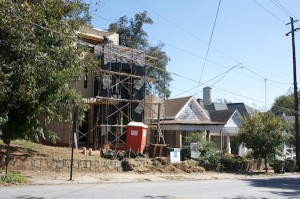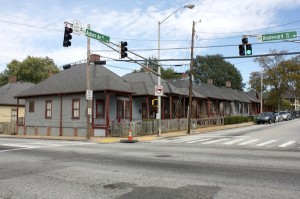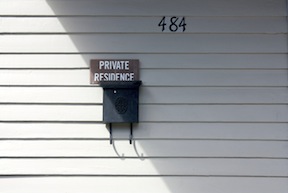"Them" in Atlanta: A gentrification photo album
16 October 2014 – David Rotenstein
 In 2007 Atlanta journalist Nathan McCall’s novel Them was published. The book is a fictionalized account of a very real Atlanta neighborhood–the Old Fourth Ward–undergoing gentrification. The neighborhood is a place where civil rights historic landmarks jockey for attention and dollars among hip bars and restaurants. A recent historic preservation battle exposed tensions that pit adapting old buildings for new uses versus tearing them down for new developments.
In 2007 Atlanta journalist Nathan McCall’s novel Them was published. The book is a fictionalized account of a very real Atlanta neighborhood–the Old Fourth Ward–undergoing gentrification. The neighborhood is a place where civil rights historic landmarks jockey for attention and dollars among hip bars and restaurants. A recent historic preservation battle exposed tensions that pit adapting old buildings for new uses versus tearing them down for new developments.
Atlanta Journal-Constitution reporter Shelia Poole turned me onto McCall’s book earlier this year. After reading the book (several times), I incorporated its setting, Randolph Street, into my bike rides from my home in Candler Park to the BeltLine’s Eastside Trail. The ride takes me from the dedicated PATH trail onto John Wesley Dobbs Avenue and past the former David T. Howard school (Martin Luther King, Jr. was a student there) onto Randolph Street where I turn south towards Irwin Street and Auburn Avenue.
I began calling it my “Them” route.
History and historic preservation have played key roles in defining the Old Fourth Ward’s brand and cultural landscape. The neighborhood’s identity is inextricably entwined with its civil rights, housing, and economic history. Historic preservation identification and documentation efforts, first; local and federal landmarking, second; and regulatory compliance through Atlanta’s historic preservation review board, the Urban Design Commission, and Section106 of the National Historic Preservation Act, third, have all contributed towards making the twenty-first century landscape in what locals have dubbed O4W.
Nearly a decade after McCall penned Them, gentrification continues in the neighborhood. Newly built homes and carefully adapted historic homes are still juxtaposed with wood-frame shotgun houses protected by iron burglar bars that hint of earlier disinvestment and neighborhood decline. Many of the places described in Them are easily identifiable: King’s Auburn Avenue birth home, the King Center, Ebenezer Church, and the Auburn Avenue Research Library. Others, like the home of protagonist Barlowe Reed at 1024 Randolph Street, are outright fictions or composites of real places. The book chronicles Reed’s adaptations to”them”: the young new–white–residents moving into and changing his neighborhood.
Them is one of a growing body of artistic works depicting gentrification. The earliest may be Walt Whitman’s 1845 essay, “Tear Down and Build Over Again.” Within the past generation, there is Spike Lee’s 1989 film, Do the Right Thing, and the plays Hallelujah Street Blues (Valetta Anderson, 2008), Clybourne Park (Bruce Norris, 2010), and Two Stories (Elaine Jarvik, 2013). These accounts have joined the volumes of academic literature that inform my understanding of gentrification.
Them is important to me because it depicts gentrification and tensions over historic buildings and spaces in a neighborhood close to the site where, since October 2011, I have been researching gentrification. In fact, the neighborhood where I began my immersion into gentrification appears in McCall’s book: “As we look around the city, we see a curious pattern taking shape. It’s happened in Summerhill. It’s happened in Oakhurst. It’s happening in Kirkwood. It’s spreading to East Point, and now we’re seeing it with our own eyes, right here in the ward,” said one character about gentrification in a meeting of the fictional Old Fourth Ward Civic League.
Before the cold weather set in and before moving away from Atlanta, I wanted to photograph the places depicted in Them. In early October I slung my camera bag over my shoulder, strapped on my bicycle helmet, and set out for the Old Fourth Ward on my bike. The photos that appear below were taken along the Them route.
~David Rotenstein (Historian for Hire) is an independent consultant working in Washington, DC, and beyond.
Click on images to see larger versions.

Downtown Atlanta skyline as seen from Irwin Street in front of the David T. Howard School, Martin Luther King, Jr.’s elementary school.

Auburn Avenue passes beneath the Downtown Connector (I-75/85). When it was completed in the 1960s, it effectively created a visual and physical barrier between Auburn Avenue’s black business district and the downtown central business district.

Tourists having their pictures taken at the entrance to the King Center and Martin Luther King, Jr. grave site.

Pal’s Lounge, Auburn Avenue at Bell Street. In Them, this corner was where the Black Leopard Café was located, “a gritty bar with a hand-painted sign hanging over the door.”

Former Masonic Lodge building, Auburn Avenue at Bell Street. Big Bethel A.M.E. Church’s steeple, with its “Jesus Saves” sign, competes for attention with downtown highrises.

Auburn Avenue Research Library. In the book, Barlowe Reed checked out an “armload of books” on mortgages and home ownership.

Marie Cowser Memorial Park is a triangular park where Randolph Street meets Auburn Avenue. In Them it was a “triangular cobblestone public space.” The park was dedicated in 2013.

The historic Atlanta Fire Department Station No. 6 at Auburn Avenue and Boulevard is now a National Park Service facility.

The Southern Food Store is located at the corner of Irwin and Randolph streets. Local tour guides note that it’s one of the oldest black-owned businesses in the neighborhood.

The Lottafruit market and cafe at the corner of Randolph Street and Auburn Avenue opened in 2006. The Atlanta Journal-Constitution in October 2006 called it the “funkiest place of all” in an article on businesses “revitalizing” the Old Fourth Ward neighborhood.

A new three-story home under construction on Randolph Street next to a row of early 20th-century cottages.

Signs appeared in the summer of 2014 announcing new condominium construction next to the Old Fourth Ward’s most visible landmark, an old water tower at Auburn Avenue and Irwin Street.

A new home developed by the Historic District Development Corporation was completed in late 2014 one block from the water tower.

“It seemed every patch of vacant land in the ward was being snapped up by speculators,” wrote McCall in Them. “Houses that went on the market usually were bought fast, and renovated even faster.”

Entrance to the Freedom Park Trail at John Wesley Dobbs Avenue, one block west of Randolph Street. In Them, community members debated asking city officials for a connection to the trail from Randolph Street.

A bridge carries Randolph Street over the Freedom Park trail and the Freedom Parkway. McCall completed Them before the arrival in the summer of 2014 of Auburn Avenue pop-up stores that include sock boutiques and a Jewish-themed gift store, the opening in 2012 of the Atlanta BeltLine’s Eastside Trail, and the arrival of a streetcar city leaders hope will continue the area’s economic development.

This building once housed the Atlanta Daily World, a historic African American newspaper. It was damaged in a 2008 tornado and is being rehabilitated for new mixed-use.

Newly completed streetcar tracks and stop in Auburn Avenue. The new streetcar line and economic development efforts make Auburn Avenue Atlanta’s version of Washington, DC’s H-Street corridor–another gentrifying historic African American neighborhood anticipating the arrival of a new streetcar route.

The Atlanta BeltLine is a relict industrial rail corridor that is accelerating gentrification in the Old Fourth Ward.














I just finished reading Them this morning. At first I was a bit skeptical about the idea of a novel about gentrification— would it avoid being preachy? Would the plot be engaging yet believable? Would the characters grow? McCall pulls all of this off effectively. By the time I was half way through the book, I wanted to spend all of my free time reading it. I was impressed by the way McCall developed his characters with just the right touch of humor (and caricature). He managed to write some excellent awkward dialogue and to raise some new and interesting questions about the legacy of Martin Luther King, Jr over forty years after his death. He shines and bright light on the notion of community. Everyone loves the idea of a community, but few people are comfortable with a community truly unfamiliar to them, whether they bring the change to a place or the place changes around them. We all crave a “safe space.” Yet, to resist this change by resisting outsiders, or to push change too quickly or insensitively (through fear) is to give in to baser human instincts.
This brings home to me my own nagging questions about revealing hidden histories and about historic preservation. As historians, we strive to be as “objective” as we are able, yet emotion inevitably drives our choices of subjects to explore and stories to foreground. But when we reveal a hidden history or preserve a significant structure, is our work done there? Or do we have an obligation to facilitate the kinds of discussions that would help people to navigate the mixed emotions that come from seeing a new “truth” somewhere they thought they understood well. I don’t know the answer, and I would love to hear comments from others.
Them uses a lot of combat metaphors. People take sides and choose to “fight for their rights.” Or they decide whether to stay and “fight the good fight.” I’ve long been uncomfortable with combat metaphors for human interaction. They seem to close off communications channels to me. I prefer building metaphors and sharing metaphors. Such metaphors call for compromise when conflicts emerge and for full discussion of those conflicts before anything is done. You can’t build a structure if you can’t rectify conflicting plans. Does that make me naive or are satisfactory compromises possible? I look forward to hearing your thoughts.